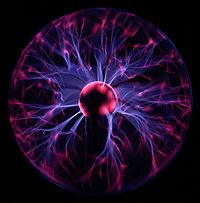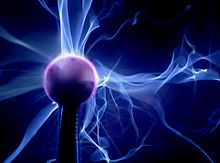- Plasma globe
-
Not to be confused with Sulfur lamp or Plasma lamp.
Plasma globes, or plasma lamps (also called plasma balls, domes, spheres, tubes or orbs, depending on shape), are novelty items that were most popular in the 1980s.[1] The plasma lamp was invented by Nikola Tesla[2] after his experimentation with high-frequency currents in an evacuated glass tube for the purpose of studying high voltage phenomena, but the modern versions were first designed by Bill Parker.[1] Tesla called this invention an inert gas discharge tube.[3]
Contents
Description
Most commonly, plasma globes are available in spheres or cylinders. Although many variations exist, a plasma lamp is usually a clear glass orb filled with a mixture of various gases (most commonly helium and neon, sometimes with other noble gases such as xenon and krypton) at low pressure (below 0.01 atmosphere)[3] and driven by high-frequency alternating current at approximately 35 kHz, 2–5 kV, generated by a high-voltage transformer. A much smaller orb in its center serves as an electrode. Plasma filaments extend from the inner electrode to the outer glass insulator, giving the appearance of multiple constant beams of colored light (see corona discharge and electric glow discharge). The beams initially follow the electric field lines of the dipole but move upwards due to convection.[citation needed]
Placing a hand near the glass alters the high-frequency electric field, causing a single beam to migrate from the inner ball to the point of contact.[1] An electric current is produced within any conductive object near the orb, as the glass does not block the electromagnetic field created by the electric current flowing through the plasma (though the insulator does block the current itself).[citation needed] The glass acts as a dielectric in a capacitor formed between the ionized gas and the hand.
Potential hazards
Caution should be taken when placing electronic devices near or upon the plasma lamp: not only may the glass become hot, but the high voltage may place a substantial static charge on the device, even through a protective plastic casing. The radio frequency field produced by plasma lamps can interfere with the operation of touchpads used on laptop computers, digital audio players, cell phones, and other similar devices.[1] Some types can radiate sufficient RFI to interfere with cordless telephones and Wi-Fi devices several feet away. If a medium-sized lamp is wrapped in grounded metal foil, capacitive coupling can transfer tens of milliamperes to ground through the foil, enough to light a small lamp or give a small arc burn. This is possible because the glass acts as a capacitor dielectric: the inside of the lamp acts as one plate, and any conductive object on the outside acts as the other capacitor plate.[3] Ozone, which is harmful to humans, may also accumulate outside of the surface of the glass orb after a few minutes of constant operation.[1]
History
A plasma lamp in action
In U.S. Patent 0,514,170 ("Incandescent Electric Light", 1894 February 6), Nikola Tesla describes a plasma lamp. This patent is for one of the first high-intensity discharge lamps. Tesla used an incandescent-type lamp globe with a single internal conductive element and excited the element with high voltage currents from a Tesla coil, thus creating the brush discharge emanation. He gained patent protection on a particular form of the lamp in which a light-giving small body or button of refractory material is supported by a conductor entering a very highly exhausted globe or receiver. Tesla called this invention the single terminal lamp, or, later, the "Inert Gas Discharge Tube."[3]
The popular product sold throughout the world today was invented by Bill Parker in 1970 as an undergraduate student at MIT.[1]
The technology needed to formulate gas mixtures used in today's plasma spheres was not available to Tesla.[citation needed] Modern lamps typically use combinations of xenon, krypton and neon, although other gases can be used as well.[1][3] These gas mixtures, along with different glass shapes and integrated-circuit-driven electronics, create the vivid colors, range of motions and complex patterns seen in today's plasma spheres.
Applications
 Plasma lamp running. Note the result when the finger touches the bulb.
Plasma lamp running. Note the result when the finger touches the bulb.
Plasma lamps are mainly used as curiosities or toys for their unique lighting effects and the "tricks" that can be performed on them by users moving their hands around them. They might also form part of a school's laboratory equipment for demonstration purposes. They are not usually employed for general lighting. However, as of recent years, some novelty stores have begun selling a nightlight plasma lamp that can fit into a standard light socket.[4][5]
See also
References
- ^ a b c d e f g Gache, Gabriel (January 31, 2008). "How do plasma lamps work?". Softpedia. http://news.softpedia.com/news/How-do-Plasma-Lamps-Work-77633.shtml. Retrieved Nov. 16, 2009.
- ^ Tesla, Nikola (1892). "Experiments with Alternate Currents of High Potential and High Frequency". http://www.pbs.org/tesla/res/res_art05.html. Retrieved Jul. 26, 2010.
- ^ a b c d e Barros, Sam (2002). "PowerLabs Plasma Globes Page". http://www.powerlabs.org/plasmaglobes.htm#%C2%A0PRINCIPLE%20OF%20OPERATION:. Retrieved Nov. 16, 2009.
- ^ Plasma Ball Night Light Makes Us Nostalgic For Bed Wetting, gizmodo.com, 2007-11-27
- ^ Plasma Night Light, 4physics.com, 2010-02-17
External links
Categories:- Gas discharge lamps
- Nikola Tesla
- Novelty items
Wikimedia Foundation. 2010.



